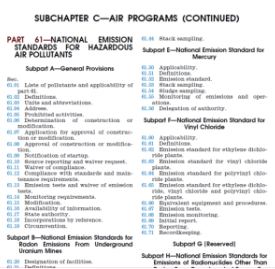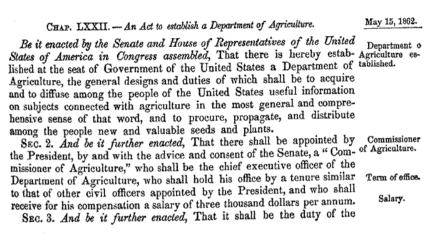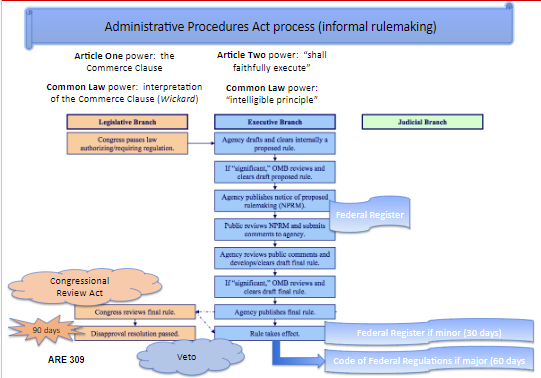Administrative Law and the Administrative Procedure Act of 1946
Administrative Law
 The Bureaucracy (Review)
The Bureaucracy (Review)
Federal Agencies created by Congress (U.S. Const. Art. I)
Execute and administer (and enforce) laws passed by Congress
President may reorganize
Environmental Protection Agency (created by President Richard M. Nixon (1970)
Types of Agencies
Cabinet - Fifteen that serve at pleasure of President (Ex. USDA, DOI, Energy)
Independent – Environmental Protection Agency
Congressional – Congressional Budget Office (CBO)
Judicial
Government Corporations – USPS, Amtrak
State agencies generally created by General Assembly and laws implemented under state rulemaking procedure
Major Federal Environmental Statutes Under EPA Administration
Clean Air Act (CAA) 1970
Federal Water Pollution Control Act (Clean Water Act) (CWA) 1972
Federal Insecticide, Fungicide, and Rodenticide Act (FIFRA) 1972
Safe Drinking Water Act (SDWA) 1974
Toxic Substances Control Act (TSCA) 1976
Resource Conservation and Recovery Act (RCRA) 1976
Comprehensive Environmental Response, Compensation, And Liability Act (CERCLA, AKA The Superfund) 1980
Meet your federal regulators
 Selected Environmental Protection Functions in Federal Agencies Outside of EPA
Selected Environmental Protection Functions in Federal Agencies Outside of EPA
U.S. Department of Interior (1849)
Bureau of Land Management (BLM) - Federal lands
National Park Service – National Parks
U.S. Fish & Wildlife Service - endangered species
Endangered Species Act (ESA) 1973
U.S. Department of Agriculture (1862)
Forest Service - Federal forest lands
Natural Resources Conservation Service (NRCS) – conservation programs
Animal, Plant Health Inspection Service - non-native, invasive species, animal and plant diseases
Food Safety Inspection Service - meat, poultry, and egg product safety
Creation of the USDA - 1862
 Selected Environmental Protection Functions in Federal Agencies Outside of EPA
Selected Environmental Protection Functions in Federal Agencies Outside of EPA
U.S. Department of Labor
Occupational Safety and Health Administration (OSHA) - workplace environment
Mine Safety and Health Administration - workplace environment of mines
U.S. Department of Defense
U.S. Army Corps of Engineers - wetlands protection & navigable waters
Department of the Air Force - hazardous waste remediation, energy & water conservation
Limitations on agency power
Constitutional
Deprive property right
Violate vested authority
(as determined by federal courts under power of judicial review)
Statutory –
authority defined by statute
Sunset provision
Institutional –
Executive restrictions
Congress: House and Senate oversight (committees)
Judicial –
review of agency action (APA) and authority (statute)
Budget – Congress restrains spending power
Constitutional limit on agency power
The Nondelegation Doctrine
Congress cannot delegate legislative powers (U.S. Const. Art. I, § 1)
Courts have allowed delegation of “micro-level” rulemaking authority, so long as…
…The authorizing statute provides intelligible principle to guide agency
The delegation to coordinate branches must contain some “intelligible principle to which the person or body authorized to exercise the delegated authority is directed to conform.” Mistretta v. United States, 488 U.S. 361, 372 (1989)
rarely invoked in modern times
Replaced by Major Questions Doctrine
implements a “clear statement rule” that courts follow to interpret clear delegations of authority by Congress to an administrative agency
most recently invoked in West Virginia v. EPA (2022)
Common Law Limitation on Agency Power: Ultra Vires
The Ultra Vires Doctrine
Latin: “Beyond the Powers”
Corporate Law doctrine applied to agencies
Agency must operate within statutory delegation
Courts offer presumption of agency authority
Injured party (plaintiff) has burden to overcome presumption in court
“… the power of [the agency] is circumscribed by the authority granted.” Stark v. Wickard, 321 U.S. 288 (1944) (ruling that judicial review of an agency action was authorized by the AAA of 1938)
Three Functions of Administrative Agencies
Rulemaking (legislative)
535 members of Congress unlikely to agree on details of complex environmental regulations
Need specialized expertise in scientific matters
Formal Adjudication of individual cases (judicial)
Executive activities (executive)
Permitting and approval of individual projects
Enforcement of rules
Other
Research
Education
Defense
The Administrative Procedures Act (5 U.S.C. Ch. 5§551 et seq**)**
Passed in 1946 following the proliferation of federal agencies New Deal and WWII
Effort to “systematize” the function of federal agencies
Authorizes judicial review of agency action by federal courts
Distinguished from Marbury v. Madison review
Imposes procedural requirements upon agencies in their function of rulemaking and other decisions
Authorizes federal courts to review compliance
Courts continually develop rules of interpretation and review
Under which pass approximately 2,500 – 4000 rules per year
Rulemaking Steps under Administrative Procedure Act (APA) in 7 steps
Identification of need and development of factual basis
may include a request for information - Federal Register
Review of Proposed Rule by Office of Management and Budget (OMB)
Notice of Proposed Rule - Federal Register
Public comment period, followed by agency consideration
Review of draft Final Rule by OMB
Final Rule - Federal Register
Major rule - 60 days after publication in FR
Impacts economy in excess of $100 Million (as determined by OMB)
Minor rule - 30 days after publication in FR
Codified in Code of Federal Regulations
Congressional Review Under APA
Agency sends draft rules to GAO and both Houses
Congressional Review Act (5 U.S.C. Ch 8 §801 et seq.) (enacted 1996)
Joint resolution within 90 days of first receipt of draft “Major” rule (impact of $100Million on economy)
Subject to Presidential veto
Retroactive to effective date
Types of rulemaking
Informal (APA §553)
Most common
Proposed rule published in Federal Register with comment period
Formal (APA §§556-7)
Rare, involves hearings with sworn testimony, much like a civil trial
Hybrid (not addressed by APA)
In common practice, informal + public listening sessions
Exempt
agency or subject matter is exempt from rulemaking by statute or by a previous regulation (which followed APA)
Negotiated Regulations (“Reg-Neg”)
Agency consults with impacted parties who help craft rule
Rule proposed through informal APA process
Public input
U.S. Const. amend. I: “Congress shall make no law… abridging … the right of the people … to petition the Government for redress of grievances.”
Informal - written comments
At least 30 days
Formal - formal public hearing, sworn witnesses
At least 30 days
Hybrid - written comments, informal public hearing
At least 30 days
Exempt
No public input, or
After-the-fact (emergency rules)
Exempt rulemaking
Military/National Security
Speed, secrecy
Not published
Emergencies
Written comment after effective date (usually date of publication)
Interpretive (agency guidance)
Not law
General policy statement
Not law

 Knowt
Knowt
